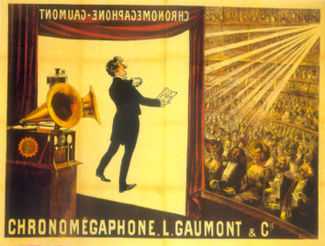Chronomégaphone
From Wikipedia, the free encyclopedia

1908 poster advertising Gaumont's sound films, showing a Chronomégaphone
The Chronomégaphone, designed for large halls, was a compressed air gramophone which employed compressed air to amplify the recorded sound.[1] It was used by Gaumont for the presentation of some of their early sound films.[2]
References
- ↑ Wierzbicki (2009), p. 74; "Representative Kinematograph Shows" (1907).The Auxetophone and Other Compressed-Air Gramophones explains pneumatic amplification and includes several detailed photographs of Gaumont's Elgéphone, which was apparently a slightly later and more elaborate version of the Chronomégaphone.
- ↑ Jon D. Witmer. "Gaumont Treasures, Vol. 2 (1908-1916)". American Society of Cinematographers. Retrieved 2012-07-31.
This article is issued from Wikipedia. The text is available under the Creative Commons Attribution/Share Alike; additional terms may apply for the media files.